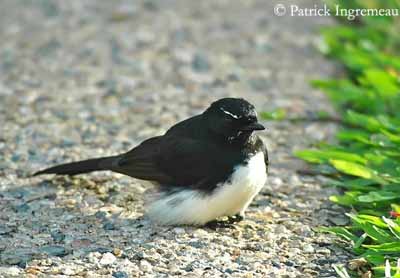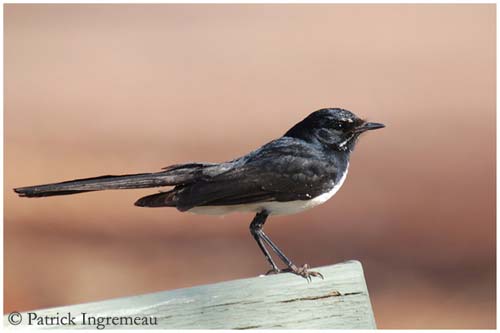
Willie Wagtail
Rhipidura leucophrys
Passeriforme Order – Rhipiduridae Family
BIOMETRICS :
Length : 18 à 22 cm
Weight : 20g
DESCRIPTION:
Willie Wagtail is one of the most popular and the largest of Australian fantails.
Adult has black upperparts. Long black tail is often fanned.
Underparts include black chin and throat, and white belly and vent. Undersides of wings and tail are dark brown to black.
Head is black with white eyebrow and moustachial stripe. Thin bill is black. Eyes are dark brown. Legs and feet are blackish.
Both sexes are similar.
Juvenile resembles adults, but it has paler, brownish feather’s edges on wings. It lacks the long tail of adults.
PROTECTION / THREATS / STATUS:
Willie Wagtail is common in most parts of its habitat, and it can be very tolerant and tame around humans, when living close to habitations.
Fr: Rhipidure hochequeue
All : Gartenfächerschwanz
Esp : Cola de Abanico Blanco y Negro
Ital : Coda a ventaglio ballerina
Nd : Tuinwaaierstaart
Russe : Чёрно-белая веерохвостка
Photos de Patrick Ingremeau
TAMANDUA
Texte de Nicole Bouglouan
Sources:
Wikipedia (Wikipedia, The Free Encyclopedia)
Birds in backyards (Birds Australia and Australian Museum)
BirdLife International (BirdLife International)
Arthur Grosset's Birds (Arthur Grosset)

VOICE: SOUNDS BY XENO-CANTO
Willie Wagtail utters wide range of vocalisations. It is a noisy bird, giving scolding and chattering notes. It often calls by night and its most common call is a rapid “chit-chit-chit-chit”, and other more tuneful sounds.
HABITAT:
Willie Wagtail lives in varied habitats such as semi-open woodlands, thickets, grasslands with some trees. It is common in urban areas, often seen hunting in parklands and other grassed areas.
This species usually avoids dense forest and treeless areas.
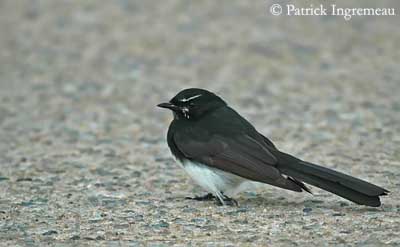
RANGE:
Willie Wagtail lives in eastern and south-eastern Australia, except northern Queensland. It is also found in northern Tasmania, in New Guinea, Salomon Islands, Bismarck Archipelago and the Moluccas.
BEHAVIOUR:
Willie Wagtail is often seen singly or in pairs. But during winter, they may gather in mixed flocks with other species.
Willie Wagtail spends most of its time feeding in exposed areas. It forages on the ground, sometimes darting and hunting for insects. While it is hunting, it wags its long tail from side to side, shakes its body, and opens its wings.
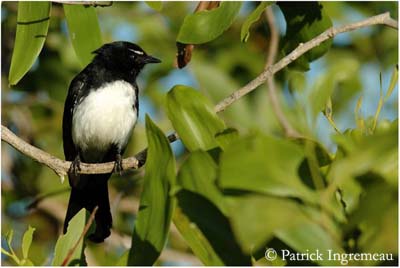
It also stalks from low branch, exposed perch, even from sheep’s back! It can hawk flying insects from these varied perches.
It often feeds in the grass with cattle, snatching insects as they are disturbed. It runs in short bursts on the ground, often wagging its fanned tail.
Willie Wagtail is very aggressive during nesting period to larger intruders such as large birds and even cows, hovering strongly over them, on back and head, while it is calling.
It can expand the white eyebrow as threat against a rival or in territorial dispute. Submission of one bird appears when it shrinks its eyebrow until becoming almost invisible.
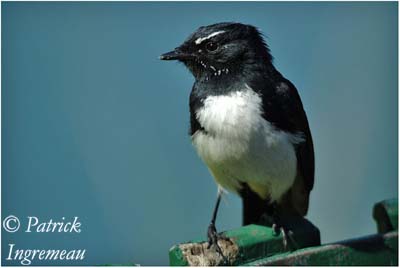
FLIGHT:
Willie Wagtail has agile and twisting flight. It hovers and hunts in the air, flying short distances at low level.
REPRODUCTION:
Breeding season occurs mainly from August to February.
Willie Wagtail’s nest is usually situated in horizontal branch in tree or other structure. This bird may reuse its nest year after year, or it uses materials from an old nest in order to build a new one.
It is a well woven cup of grasses. Exterior is covered with spider webs, and interior is lined with soft materials such as fine grasses, hair or fur.
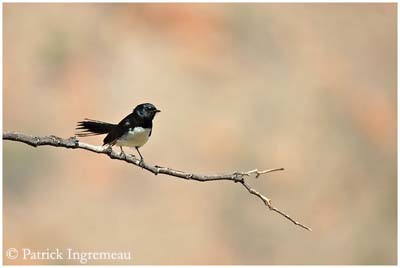
Female lays 3 cream-coloured eggs, with grey and brown markings. Incubation lasts about 14 days, shared by both adults. Young leave the nest two weeks later. They remain with parents until the next clutch begins. At this moment, they are driven away by adults.
In good weather conditions, this species can produce four successive broods per season.
DIET:
Willie Wagtail feeds mainly on insects and small invertebrates. It hunts gnats, flies and small moths.
